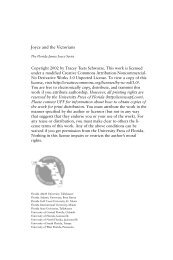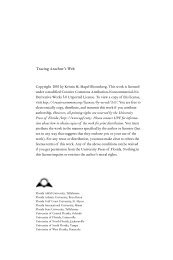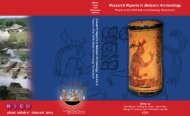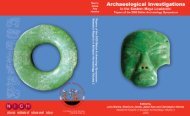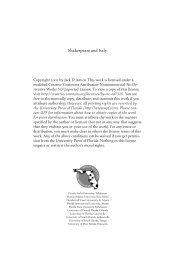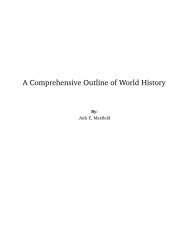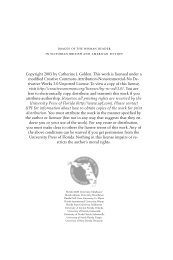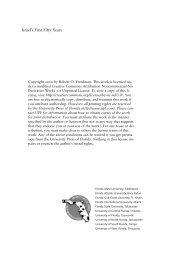Bernard Shaw's Remarkable Religion: A Faith That Fits the Facts
Bernard Shaw's Remarkable Religion: A Faith That Fits the Facts
Bernard Shaw's Remarkable Religion: A Faith That Fits the Facts
Create successful ePaper yourself
Turn your PDF publications into a flip-book with our unique Google optimized e-Paper software.
90 <strong>Bernard</strong> Shaw’s <strong>Remarkable</strong> <strong>Religion</strong><br />
Dramatic Techniques<br />
It is not enough just to dismiss conventional, or traditional, techniques. A<br />
new artistic vision requires a new method of presentation—new techniques.<br />
Shaw experimented considerably before arriving at a distinctly<br />
Shavian mode, a style optimally suited to his particular perspective: an<br />
aes<strong>the</strong>tic of Shavian realism to match <strong>the</strong> realism of Shavian vision. His<br />
difficulty was in large part that his picture of <strong>the</strong> world was so unusual, so<br />
foreign to anything his audience expected, that he could not merely<br />
present it as he saw it, for <strong>the</strong>y would insist on trying to twist it into something<br />
familiar, something <strong>the</strong>y could understand. Failing to do this, <strong>the</strong>y<br />
were merely shocked or annoyed. The evolution of Shaw’s distinct style<br />
was driven by his various attempts, first to reach his public—to have his<br />
plays produced or published—and second truly to communicate with <strong>the</strong>m<br />
once he had <strong>the</strong>ir attention.<br />
At least three distinct yarns are woven into <strong>the</strong> fabric of Shaw’s particular<br />
dramatic technique, from <strong>the</strong> beginning of its evolution to it most mature<br />
form. First is his use of traditional <strong>the</strong>atrical forms and conventions,<br />
second his insistence that his characters be “real” people shown from <strong>the</strong>ir<br />
own point of view, and third <strong>the</strong> belief that a dramatist must be an “interpreter<br />
of life,” not merely a recording machine. The second two are <strong>the</strong><br />
pillars of his dramatic realism and grow directly out of his view of <strong>the</strong><br />
world. The first is not our major concern, but a few words are necessary to<br />
clarify its relation to <strong>the</strong> essentials of <strong>the</strong> Shavian dramatic method. A serious<br />
artist conveys a vision of <strong>the</strong> truth. The style of such an artist is not<br />
an aes<strong>the</strong>tic end in itself but a means to a philosophical end. Methods are<br />
always shaped by purposes. When Shaw used popular <strong>the</strong>atrical conventions,<br />
he did so exactly as far as it suited his purposes. Whenever <strong>the</strong> popular<br />
forms conveyed a vision different from his, he ei<strong>the</strong>r abandoned or<br />
subverted <strong>the</strong>m. <strong>That</strong> is why he cheerfully admitted using <strong>the</strong> old-fashioned<br />
tricks of comedy and melodrama but strenuously objected to any<br />
suggestion that he allied himself to <strong>the</strong> well-made play.<br />
The Well-Made Play<br />
The well-made play is not defined by <strong>the</strong> various tricks it uses, for most of<br />
<strong>the</strong>se go back at least to Plautus and have been brazenly exploited by such<br />
certified dramatic geniuses as Shakespeare and Molière. The well-made<br />
play represents something foreign to genius: a particular aes<strong>the</strong>tic, <strong>the</strong> expression<br />
of a petty worldview that posits economy and respectability as



